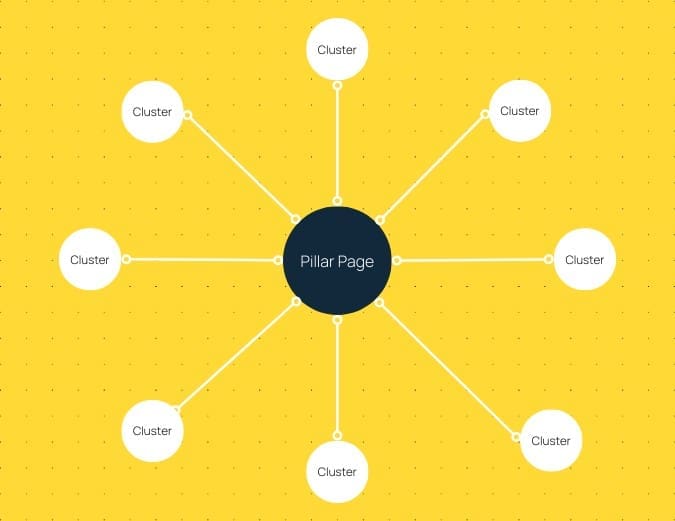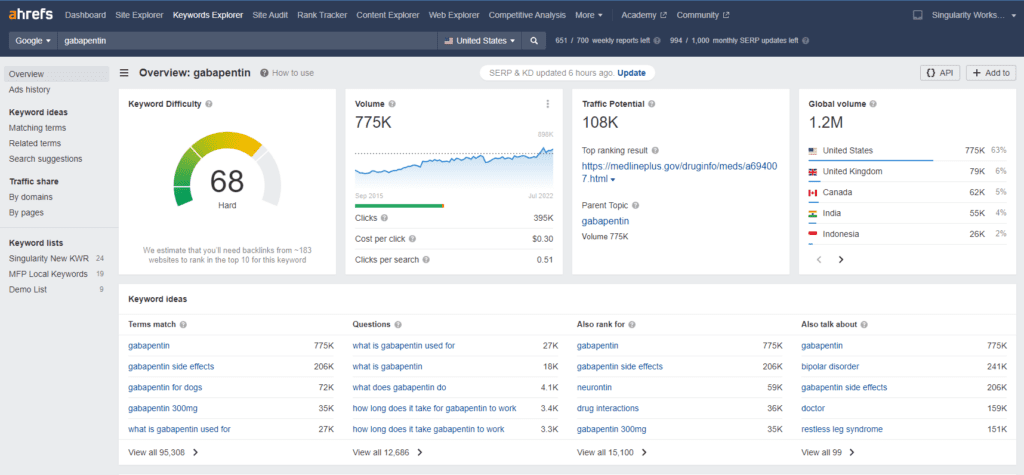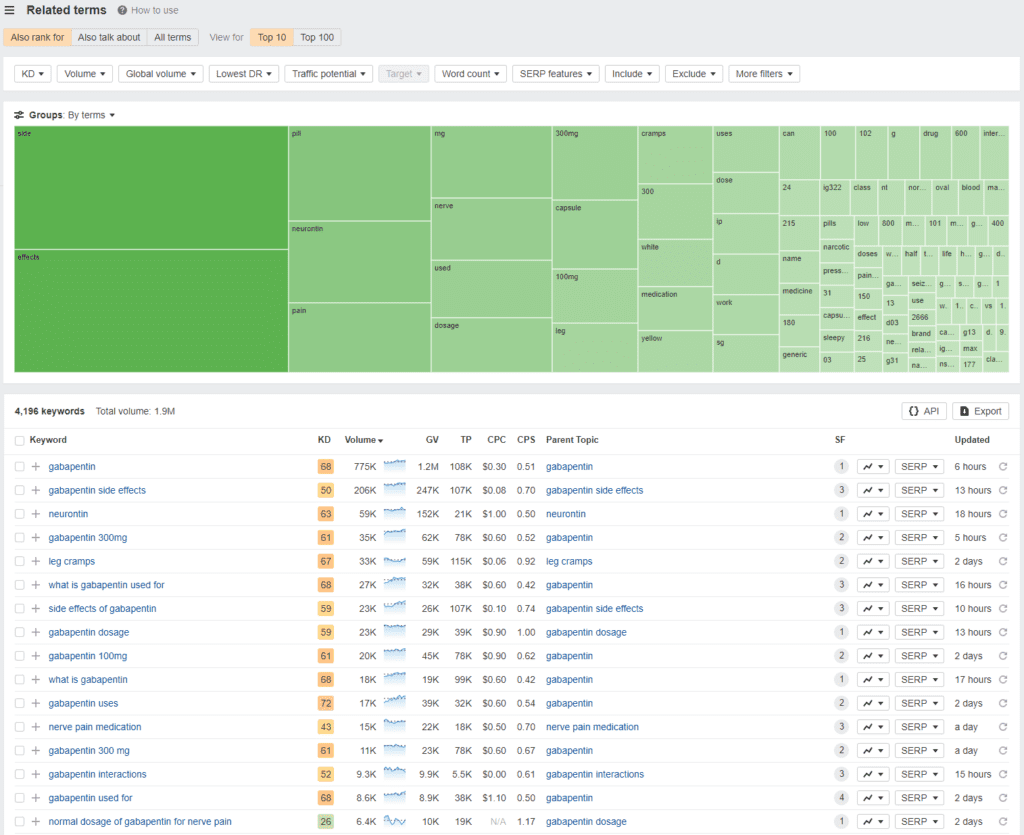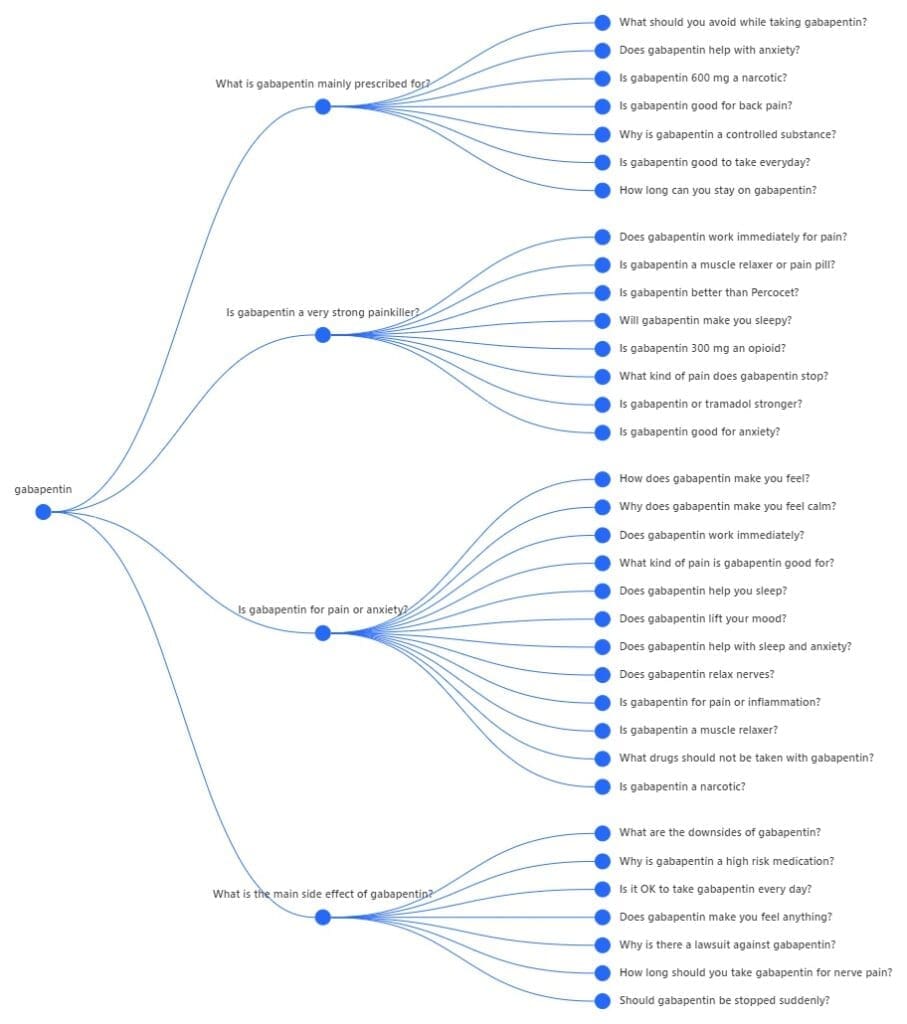Table of Contents
What is this – This post gives you a breakdown of what you need to know about topic clusters in 2023. As search engines continue to move toward serving searcher intent and away from keywords, understanding and implementing topic clusters is becoming a key part of a successful content strategy.
Who is it for –
- Brands that are struggling with low organic traffic
- Teams that are struggling to come up with effective content ideas
- Anyone looking to move away from writing generic “SEO content”
What to expect – Below, you’ll find an overview of what topic clusters are, why they’re important and how to start defining them for your website.
You’ll also see some real world examples of what this looks like in action, making it easier to understand and start executing on this ideas quickly. Topic clusters aren’t just a concept to understand, they’re something your team needs to be implementing now.
In the world of SEO, topic clusters are groups of content that focus around a single subject matter. Each of these clusters contains a broad “pillar page” that offers a high level overview of the topic, along with a series of more granular “cluster pages” that go into detail about related subtopics.
With the help of clear content titles and effective internal linking, you’ll boost your rankings and give your audience a reason to stay on your website and engage with your brand.

Not only is it helpful for your rankings, but depending on your industry, you may be able to generate a scalable content model across a host of topics, giving you a long term content plan with just a few hours of research. For example, if your audience tends to ask the same 5 questions about 3 of your product offerings, that’s 15 pieces of valuable content you can plan and produce with minimal effort.
How topic clusters effect your rankings
The primary goal of any search engine is to provide the most accurate, trustworthy responses to a given query. By producing clusters of content around a given topic, you’re giving a number of strong signals to search engines that the pages on your site are exactly what they’re looking for. When the content is high quality, you’re also repeatedly demonstrating that you’re a knowledgeable authority in your space and your content is worth reading.
All else being equal, a website with 20 pages focused on a single topic will rank better than a site with a single page covering 20 topics.
Effective topic clusters help educate your audience
If you’ve ever clicked on a blog post and found yourself opening 5 tabs of their related posts along the way, you’ve seen effective topic clusters in action.
By producing so much content related to a given topic, you’re able to go into more detail about certain subtopics, giving your audience more helpful reading to do and often providing useful resources for them to use. This doesn’t just tell search engines that you know what you’re talking about, it also makes it clear to users that you’re a wealth of information on a topic they care about.
This type of user experience gives users a reason to remember your site and begins to establish a connection with them before they make contact.
Be deliberate with your internal linking. It matters.
Proper internal linking is important for both users and search engines. It helps users to discover more valuable resources on your website and it makes more clearly defined topic clusters for search engines to recognize. In general, internal linking also passes additional authority to the pages being linked to.
As we’ve known for years now, more internal links correlates with improved rankings.
Since these clusters have natural crossover between them, you’ll have ample opportunity for naturally internal linking. For your most valuable content, you can also implement a “related reading” section that highlights some of your top content for users to check out.
One cluster at a time or rotate?
The more in depth a cluster is, the better it’s going to perform. The thing is, if you’re like most brands and only have capacity to produce 2 to 4 pieces of quality content each month, you have a difficult decision to make. Focus all of your attention on one topic cluster at a time or spread that capacity out over several?
If hiring a new writer(s) is in the budget, this is obviously the best outcome by far — quality writers can be more cost effective than you might think.
If new writers aren’t an option, the decision comes down to two elements:
- The amount of traffic your website sees each month
- The value each topic cluster represents for your brand
If your site is already getting a good amount of traffic, suddenly switching content to focus on just one niche for 6 months straight isn’t the best user experience. On the other hand, if your site is a digital ghost town, writing one cluster at a time will bring you the fastest results.
The other element here is around revenue opportunity. If one cluster represents 90% of the value to your brand, that one should take priority over the rest, for obvious reasons. Rank for your bread and butter terms before you put any time into those ancillary offerings.
A real world example of a SaaS topic cluster model
Earlier this year, we built out a topic cluster model for one of our SaaS SEO clients in the medical space. They offer counseling and medication to address anxiety and sleep problems.
As you can imagine, this space offers an overwhelming amount of content opportunities. Wrangling those into a logical and effective order was a challenging task made manageable by topic clustering.
In the end, this is what a popular cluster looked like:
Pillar Page
What is Cyclobenzaprine
Cluster Pages
Cyclobenzaprine dosage
Cyclobenzaprine for sleep
How long does cyclobenzaprine last?
Cyclobenzaprine side effects
Is cyclobenzaprine addictive?
Cyclobenzaprine vs Diazepam (Valium)
Cyclobenzaprine vs Alprazolam (Xanax)
Cyclobenzaprine vs Lorazepam (Ativan)
Not only did this give us a rich array of topics to cover, it was also something we were able to use for the other medication they offered.
Just a few examples:
| What is Gabapentin | What is Trazodone | What is Hydroxyzine Hydrochloride |
| Gabapentin dosage | Trazodone dosage | Hydroxyzine dosage |
| Gabapentin for sleep | Trazodone for sleep | Hydroxyzine for sleep |
| How long does gabapentin last? | How long does trazodone last? | How long does hydroxyzine last? |
| Gabapentin side effects | Trazodone side effects | Hydroxyzine side effects |
| Is Gabapentin addictive? | Is trazodone addictive? | Is hydroxyzine addictive? |
| Gabapentin vs Eszopiclone (Lunesta) | Trazodone vs Zaleplon (Sonata) | Hydroxyzine vs Eszopiclone (Lunesta) |
| Gabapentin vs Zaleplon (Sonata) | Trazodone vs Estazolam (ProSom) | Hydroxyzine vs Zaleplon (Sonata) |
| Gabapentin vs Triazolam (Halcion) | Trazodone vs Flurazepam (Dalmane) | Hydroxyzine vs Zolpidem |
This is just a snippet of the topics that had relevance and search volume, ultimately giving us exponentially more topics to cover following a check of keyword volumes and relevance.
How to define your own topic clusters
To get the most out of the topic cluster model, take the time to define your entire cluster(s) before you even think about writing content. Trying to decide on topics one at a time will leave opportunities on the table and increase the amount of time you spend on research in the long term.
Here’s a look at how to define those topic clusters for your website.
1. Decide on the top-level topics you want your brand to be associated with
Building your business’ identity around topic clusters is putting the horse before the cart. Before you dive into keyword research, you need to determine what direction you want to head, what top-level topics you want to cover, then do your research from there.
2. Audit your existing content
Once you’ve identified the general topics you want to cover on your site, check to see what content you might already have around this topic. Even if the current pages are lackluster, it’s generally faster to refresh existing content than to start from 0.
Here’s what to look for during this audit:
- Which pages are relevant to your intended direction?
- Is the quality of that content sufficient?
- Are there several pages that cover the same topic?
- Do those pages rank for any relevant keywords?
- Are those pages getting traffic or conversions?
Once you have this better understanding of the content on your site, it’s time to start defining the new clusters.
3. Use keyword research to start identify pillar and cluster pages
While quality website content is about more than just keywords, this research gives you a strong place to start — particularly for those pillar pages.
Sticking with the above medical SaaS example, here’s an overview of what that process looks like for a cluster around the drug Gabapentin.
Use Ahrefs’ keyword explorer to see the metrics and relevant keywords
Ahrefs gives us an excellent overview of the landscape around this topic. From the below screenshot we can see that it’s a competitive term that has the potential to drive over 100,000 new visitors every month from close to 800,000 searches. It also gives us a host of other keyword ideas and relevant questions to investigate.
Since this client had the clout to go after such a competitive term, this made “What is Gabapentin?” is an ideal pillar page for us to build a cluster around.

Check the ‘Related terms’ to identify cluster content
Now that we have our pillar page clearly identified, it’s time to start digging into the relevant sub-topics we can cover in this cluster. Not only does this page give us a long list of relevant keywords to look through, the green snapshot at the top ultimately shows us searcher intent.
As the screenshot below clearly highlights, people have a lot of questions about the side effects of Gabapentin (the two largest groups in the green chart). This is backed up by the search term “gabapentin side effects” being the 2nd highest volume term in this list. With over 200,000 monthly searches, we’ve already identified our first cluster page.

Making our way down that list, we can pick out other key topics that also make for ideal cluster content. Just from this screenshot alone, we can see that topics like dosage and interactions are also high-volume winners. Continuing on, we start to see common questions people have around this drug as well. For example “does gabapentin make you sleepy” and “how long does it take for gabapentin to work”.
With less than 10 minutes of research, we’re already starting to build out a strong cluster here with a combined search volume of more than 1,000,000. When we continue down this path and combine this with some competitor research, we end up with a large and very valuable topic cluster that’s almost ready to start executing.
Go beyond keyword research to identify cluster topics, too
While keyword volume is important for the topic cluster model, don’t let it be the only thing you base your modeling around. It’s perfectly okay to mix in content topics that have 0 search volume, so long as they’re relevant and genuinely helpful.
You can use tools like AlsoAsked.com to compile a list of “people also asked” questions from Google. Not only does this give you a list of great ideas to investigate, it can also spark some creative concepts for future content as well.

The other fantastic resource that gets overlooked here is your sales team. They’re already talking to new and prospective customers every single day. Sit down with them and ask them a few questions that can help you define a killer content cluster.
- What are the questions you get asked repeatedly?
- Are there any concepts you find yourself having to explain over and over?
- Do prospects often share similar fears of concerns around this industry or our offering?
- Are there any resources you wish we had on our website that you could direct people to?
- Are there any misconceptions you regularly come across around this industry or our offering?
When you take the time to sit down and really listen to what they have to say, you’ll be amazed by just how many great topics (and internal improvements) you’ll come across in the space of an hour or two.
Compile and prioritize
By this point, you have a list of your relevant existing content along with a ton of great new topics to start writing about so it’s time to start putting them into a logical order. What order you put them in will depend on your current position, internal priorities and the value each topic offers your audience.
Generally, you’ll want to start by getting those pillar pages written and published. From there, the order of your cluster pages will depend on how well established your website is. If you’re a new brand, prioritize those low competition keywords first for an improved time to rank.
For more established brands with existing organic traffic, the cluster page priorities should put the user first — order those pages by what provides the most value to your audience.
Keyword cannibalization and topic clusters
Keyword cannibalization is when you have 2 or more pages that cover the same information, competing for the same keyword(s). In these instances, it can be hard for search engines to determine which is the best page to show in the rankings.
Since the whole point of topic clusters is to produce multiple pages around the same theme, it’s important to clearly define the focus of each page. This means setting out your primary and secondary keywords in your initial brief, along with included notes about the related topics you’ve already covered on the website.
With this information in the brief, your writers have all the info they need to produce a uniquely valuable piece of content. This way, they can include effective internal linking and avoid that dreaded cannabilzation battle.
The ultimate line of defense here is having a single person give a final overview of all content before it goes live. When they see every new page that goes on the site, they’re more capable of identifying unnecessary crossovers before they hit Google’s index.
Common client questions around topic clustering
While effective SEOs are familiar with the topic cluster model, this is often new territory for our clients, so we tend to get a lot of the same questions. They’re all valid questions that are worth answering, so let’s take a look.
Didn’t we just write about this topic? Why are we doing it again?
Yes, we just wrote content related to this same theme but this new page has a clearly defined niche within it. This helps us to boost the topical relevance of that high-volume pillar page while offering more detailed, actionable advice for your audience.
These cluster pages target low volume terms. Surely we’re better off choosing a new topic?
Within reason, the more helpful content and internal links you can provide around that pillar topic, the stronger that page is going to be. The benefits of writing for these lower volumes terms is two-fold:
- Boosting the strength of the pillar page that targets high volume terms
- Rankings for low volume, low competition terms for additional, targeted traffic.
Why are we spending so much time writing for low volume keywords?
It’s best to look at the topic cluster model as a single strategy, rather than a series of individual content pieces. Not all of those pages will bring a lot of traffic individually and that’s okay. As a collective, each cluster is expected to perform well and bring you a mix of traffic from all sectors of the marketing funnel.
While you can expect good volume from the broad pillar terms, the lower volume from those more niche cluster pages tends to be more targeted — from people more educated on the topic and/or closer to making a buying decision.
Consider the difference between these two terms and the audience intent behind them.
Best colored pencils: 5,900 searches per month
Where can you buy prismacolor colored pencils: 80 searches per month
While the first term has a much higher search volume, it’s also going to be more difficult to rank for and attracts an audience that’s very early in the buying cycle. On the other hand, compiling a cluster of terms like the second one will net you a collection of low volume terms that are much easier to rank for and attract an audience that’s trying to buy right now.
When you combine the high volume terms with a series of these low volume, high-converting terms, this is where you really start to gain ROI from your SEO.

